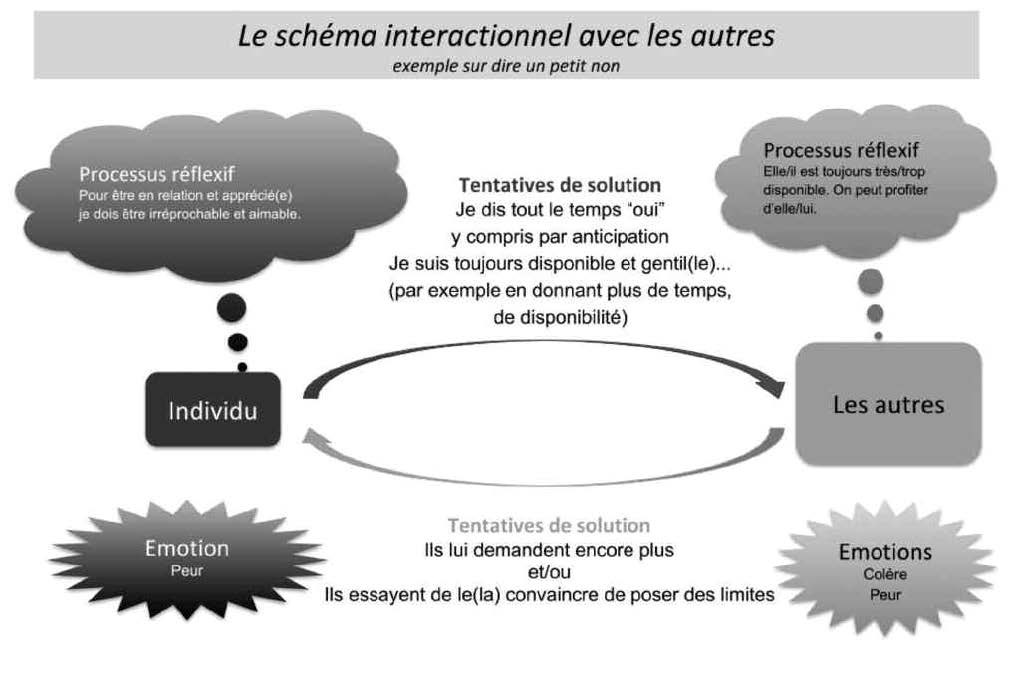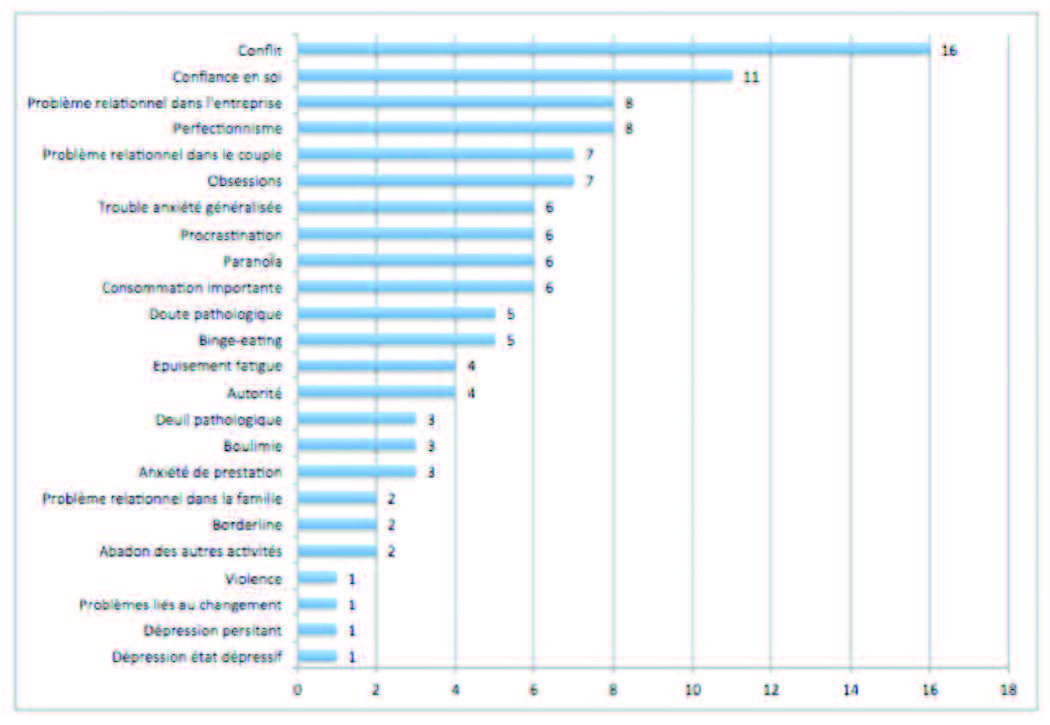Say a little "no"
Grégoire Vitry and Claude de Scorraille
Article published in Hypnosis & short therapies out of series n°16
Without the ability to say no, there is no true yes.
“To be free is to know how to say no. Jean-Paul SARTRE
Clinical case: Samira sacrifices herself
When I meet Samira, she is a home help. She is on sick leave. The organization she works for has contacted me and told me that they are worried about her because she is not well. She said to me: “
I can't take it anymore, I'm exhausted. I spend my time doing the best and working day and night to ensure that the people I care for are treated well. I only do what is asked of me. I strive to provide perfect work. And I realize that it's useless when I see how my colleague Jean-Félix trashes my work. »
Samira does a lot more than she should. For example, when the family she works for most often asks her to take care of the errands by going to buy food that is hard to find, she is quick to take her car to drive for miles.
... "you know, a bad 'yes',
we charge a thousand times over"

Or when her colleague Jean-Félix leaves the medicine boxes in a mess, she will put all the boxes back in order only to realize that the next day they are mixed up again. And deep down, she said to herself: “ Really, this work is painful, neither done nor to be done. So Samira starts leaving post finally start And there, boom! it's just the opposite that happens , because his colleague ended up complaining about Samira's attitude which he finds unbearable. So I ask him:
- Therapist : " In the end, would you say that you spend your time trying to take good care of the people in your care by accepting everything that is asked of you, or would you rather say that you find it difficult to say no what doesn't suit you?
- Samira : Yes, it's true that I realize that I tend to accept everything I'm asked to do for the best, until the moment I can't take it anymore, and then the risk is that I drop everything. »
Here we have the typical structure of a person who sacrifices himself by saying yes to everything and who ends up turning it against himself. I then tell him:
- Th . “ a bad “yes”, we charge a thousand times over. There
, I see Samira sinking into her chair while staring at me . I feel that she thinks a lot and that she is disturbed by this reframing. I continue :
- Th . “ You are like those people who end up sacrificing themselves and exhausting themselves by saying yes all the time. And you know what, the worst part is that in the end not only are you exhausted, but in addition the others end up resenting you. What I propose to you is that between now and the next
... she got a taste for
daring to say “no”
times you can practice saying a tiny “no” every day. It is not a question of putting you in difficulty or in danger, but for example of saying a small "no" which concerns something trivial such as: "I will take care of the shopping a little later", whereas normally you would have done it immediately; or to be able to say: “I would like to make you happy, unfortunately I don't drink coffee”, when someone offers you a coffee. »
Samira came back a fortnight later, telling me that it had scared her to say a little "no" every day, but that in the end she had the impression of feeling a little more free. At the end of the therapy, Samira tells me that she has taken a liking to daring to say "no" and that she realizes how much she felt trapped in a kind of sacrificial mode which she does not didn't even realize.
Clinical case with use of the reframing of “relational prostitution”
Reported testimony (Paul Watzlawick et al., 1974): “ A single woman had very easy affairs. On the one hand she felt devalued, but on the other hand she saw no other way to escape the depressing idea that otherwise no man would want her company. In addition and unfortunately, she felt totally unsatisfied after each sexual intercourse and therefore completely "bad in bed". Usually she was too ashamed of herself to see the same partner again and would start over with another.
.. all his energy is devoted to trying
to satisfy others by saying "yes"
What she did not see was that, under these conditions, the attempts at a solution (Vitry et al., 2021a; starting over with another person who was only interested in her sexually) were in fact her problem. . To get her out of this vicious circle, and according to our rule that the therapeutic intervention is about the “solution”, we gave her the following guidelines. She would have to tell her next partner that, for reasons she couldn't reveal, but which were very symbolic in nature, she couldn't have sex unless he first gave her a quarter - but it had to be an old silver coin, not one of those new alloy coins. Once again, we have not made this requirement explicit. The implications she saw there shocked her, but she was otherwise interested enough in therapy to want to pursue it, which left her with no choice but to stop sleeping with anyone. She thus discovered that men did not let her down simply because she did not sleep with them. In this way, a change was achieved, even though the patient did not follow the guidelines. This leads us to another form of intervention. »

General
Context
They are people who want to avoid conflict. The person acts like a "relational prostitute" and of course does not feel like they act like that at all, because their way of acting with others is guided by high moral principles which become rigid: they have good intentions. Moreover, when asked, she says of herself that she is a nice person and full of empathy. At the same time, she seeks the approval of others, which she often obtains. Moreover , she obtains the approval of others on the basis of what she gives them and what she does (for example, she can give time, availability, attention, affection, she seeks to render service even beyond what is asked of her...).
What she implements means that she is appreciated only for what she does (like the services she renders, or the time she devotes) and not for what she is. The others end up only becoming opportunistic with her. And she does not realize that she has fallen into this trap where she does not dare to frustrate the other. Ultimately, she's scared of rejection. She is so that all her energy is devoted to trying to satisfy others by saying "yes". She gives of herself to “please others”; and she feels a certain pleasure in doing so. But she ends up being disappointed to see how little “real” interest she arouses. To bring this profile of person to allow themselves to say "no", where they say "yes" out of habit, you have to hit hard and give them tools that will gradually help them to assert themselves.
The reframing of relational prostitution according to Giorgio Nardone
“ I call 'relational prostitute' a person who thinks it is much easier to obtain the approval of others by continually satisfying them (...). The problem in this case is that the one who always says yes sets up a scenario which structures itself, and that once it is structured and manifested to others, it is easy to dread showing oneself under a another day, to such an extent that the person remains a prisoner of the role they have constructed for themselves (...) ” (Nardone & Balbi, 2012, p. 127).
Verbatim transcription
“ Can I use a strong term? Relationship prostitute. you prostituted yourself so that everyone would show you that they love you. But really, the scam is that everyone loves you for what you do, not who you are. And in yourself, you keep the idea: “if they knew exactly what I am, they would all reject me”. In the end, it makes you feel even more alone, since you receive love, esteem, but only for what you do, not for who you are. Therefore , what has helped to protect you has actually depressed you, and continues to depress you, since it confirms even more your incapacity and your loneliness – the fact that you are hopelessly alone ” (p. 125).

The image of "relational prostitution"
is repulsive and frighteningly effective
The image of “relational prostitution” is repulsive and frighteningly effective. It is still necessary to introduce it in a strategic way so as not to produce a shock such that it could weaken the relationship with the speaker. Generally people who suffer from a fear of rejection such that they are ready to say all the “yes” possible, recognize themselves very easily in this image of “prostitute”. However, it is very helpful to play with them and make them guess what it is, with the help of paraphrases and suggestive innuendos that lead very quickly to the track... (Wittezaele & Nardone, 2016).
Objective of the reframing: to create an aversion to the rigid scenario of saying “yes” to everything; goal of the prescription: gradually practice saying “no”
Three ways to learn to say “no” according to Giorgio Nardone (Milanese et al., 2007):
- The “no” as an expression of an inability to say yes. “ I would like to please you, but I cannot do what you ask of me . Expressed this way, no preserves the relationship.
- The “no” that takes priorities into account. “ I could do it, but right now I have other priorities. »
- The “no” which is positioned one degree above and clearly means: “ It does not suit me . »
Encyclopedic file
SAY A LITTLE “NO”
Other technical names used for this prescription
› Relational prostitution (reframing)
Conflict, relational prostitution and strategic systemic approach
In line with Nardone's research, Muriana and her colleagues propose reframing vis-à-vis the original beliefs, sowing doubt as to the validity of the latter. To a person described as caught in a positive utopia, the therapist may suggest: “ You have always sought to please others, with the best intentions and for your peace of life, in a kind of “relational prostitution”, which has made you blind even to the most obvious differences. Or to a person trapped in a projective negative utopia: “ You have always blindly believed that, by being a blameless person, others were the same, exposing you to a condition of great fragility and giving, in short, power to others (Delroeux, 2008).
Grégoire Vitry (2021) recalls that: “ The work of Rapoport (1967) cited by Watzlawick (1988) allows the latter to show how the dynamics of conflict arise. If it can be effective at the start, authority can end up generating in the other a resistance all the stronger as the insistence is great. Unable to impose their limits, the controlling person most often feels anger or even guilt, pain, fear or even shame. This attempt to control the other is frequently associated with other similar attempts such as imposing solutions on the other, wanting to convince, making people feel guilty or despising. Growing in frustration, the person may also want to repress their own emotional reactions. »

Various researchers have noted the relevance of a circular reading of conflicts based on the systemic and strategic approach (Bériot, 2014; Scorraille, Brosseau, Vitry, 2017; Milanese et al., 2018; Valitova, Besson, 2020) .
Objective
Create an aversion to the rigid scenario of saying yes to everything, in particular by reframing "relational prostitution", and put the patient/client in a position to gradually expose himself by saying small "no", while preserving the quality of the relationship with his interlocutor, until he can position himself and assert himself without fear.
Thanks to the prescription and the progressive evolution of the “sorry, I would like to but I can't”, I make sure that the patient completely reverses her usual mode of interaction, but that she does it very gradually. This is important, because if I asked her to show herself as she really is, she wouldn't be able to, because she probably doesn't even know how to distinguish the person's mask anymore (Nardone & Balbi, 2012) (Wittezaele & Nardone, 2016).
Strategic Therapy Helped 80% of Patients
Achieve Significant Improvement
For what types of problems is this prescription used in the case of:
- Disorders related to trauma and stressors : burn-out / chronic fatigue syndrome / exhaustion, fatigue;
- Obsessive-compulsive disorders : obsession / perfectionism / procrastination / pathological doubt;
- Relationship problems : relationship problems with oneself or others with loss of self-confidence / relationship problems at school / relationship problems in the family / relationship problems in the couple / relationship problems in the company / conflicts;
- Personality disorders : borderline / paranoia;
- Addiction - Alcohol ;
- Sexual disorders.

Problems and pathologies for which
the “say a little no” prescription has been used
The texts that cite this prescription
For relational prostitution:
- Nardone G., Balbi E. (2012), Crossing the sea without knowing the sky, Brussels, Satas.
- Del roeux O. (2008), Palo Alto brief therapy: the interactional approach to depressive situations, “Family therapy”, no. 29 (4), p. 513.
Statistics from the SYPRENE - LACT Research program
“Say a little no” is one of the 20 prescriptions most used by stakeholders in the strategic systemic approach.
This prescription was used in 8% of cases.
Base: 118* cases where “saying a small no” was implemented
*The prescription listed in the table is part of a therapeutic process for which there may or may not be comorbidity.
For example, for a patient for whom the practitioner has established 3 diagnoses of problems/pathologies, this prescription will be counted for each one.
Overall, all issues combined, the analysis of data from 1,150 patients from the SYPRENE network (Systemic Practice Research Network) suggests, as published in the research journal Journal of Family Therapy (Vitry, 2021b), that
therapy helped patients achieve dramatic improvement.
The results indicate a problem solving improvement rate of 80% as rated by practitioners, and 90% as rated by patients. The evaluation of efficiency shows encouraging results obtained with an average of 5.4 sessions over an average period of 5.3 months.
This article is partly taken from the book:
Vitry G., Garcia-Rivera T., de Scorraille C., Paoli B., Brosseau O. (2019),
Strategies for change: 16 therapeutic prescriptions, Toulouse, Erès.
Thanks to Giorgio Nardone, Claudette Portelli and Olivier Brosseau for their expert advice.
BIBLIOGRAPHY
- Bériot D. (2014), Manager by the systemic approach, Eyrolles.
- Milanese R., Mordazzi P., Nardone G. (2018), Strategic Coaching.
Transforming limits into resources, Enrick B. Editions. - Rapoport A. (1967), Fights, debates and games, Dunod.
- Scorraille (de) C., Brosseau O., Vitry G. (2017), When work hurts, InterEditions.
- Valitova A., Besson D., (2020), Interpersonal Communications at core of conflicts'escalation in Organization.
The interplay of interpersonal communication escalation, people's habitus and psycho-sociological processes are more important than contextual factors, “Journal of Organizational Change Management”. - Vitry G. (2021), Practices and efficiency of the strategic systemic approach in the management of mental health disorders, Doctoral dissertation, Paris 5. - Vitry G., Garcia-Rivera
T., de Scorraille C., Paoli B., Brosseau O. (2019), Strategies of change: 16 therapeutic prescriptions, Toulouse, Erès.
- Vitry G., de Scorraille C., Hoyt MF (2021a), Redundant attempted solutions: 50 years of theory, evolution and new supporting data, “Australian and New Zealand Journal of Family Therapy”.
- Vitry G., Pakrosnis R., Brosseau O., Duriez N. (2021b), Effectiveness and efficiency of strategic and systemic therapy in naturalistic settings: Preliminary results from a systemic practice research network (SYPRENE), “Journal of Family Therapy” , Online, p.
1-22. - Watzlawick P. (1988), How to successfully fail: finding the ultrasolution, Threshold.
- Watzlawick P., Weakland JH, Fisch R. (1974), Change: principles of problem formation and problem resolution, New York, Norton;
in French (1975), Changes: paradoxes and psychotherapy, Seuil. - Wittezaele J.-J., Nardone G. (2016), A logic of mental disorders. Systemic and strategic operative diagnosis, Seuil.
GREGOIRE VITRY
Researcher in psychology and sociology at the University of Paris-Descartes (Cermes3) and Paris 8.
Systemic therapist, director of LACT and president of Sypres (Union of systemic practitioners). A graduate of the School of Palo Alto, he has been passionate about the world of complexity for many years. Since 2016, he has been developing SYPRENE, a PRN network (Thurin et al., 2012) using a systemic approach, notably allowing him to improve his practice in close collaboration with the academic world. Co-author for the books When work hurts (InterEditions, 2017) and Strategies for change: 16 therapeutic prescriptions (Erès, 2020).
CLAUDE DE SCORRAILLE
Psychologist, psychotherapist, supervisor, speaker and trainer. President and co-founder of LACT. She has been applying the systemic and strategic brief therapy of the School of Palo Alto and the CTS of Professor Giorgio Nardone for more than fifteen years. Intervener at the CSAPA in Montreuil, a consultation center specializing in addictions. Leads the consultation center specializing in obsessive and compulsive disorders (OCD) at LACT in partnership with the OCD Clinic®. Co-author of the books When work hurts (InterEditions, 2017), Strategies for change: 16 therapeutic prescriptions (Erès, 2020), Towards a pragmatic humanism.